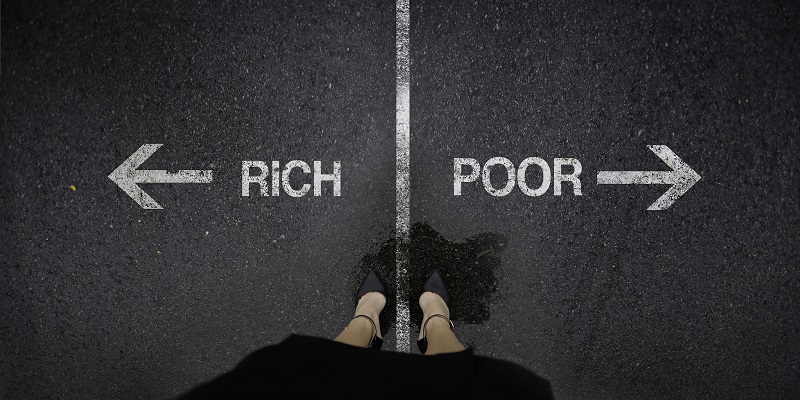Editor’s note: Today is a very special day at RiskHedge. Read to the end to find out why…
STEPHEN: Justin, you’ve been very quiet lately. You’ve shut down all your research services.
Let’s tell RiskHedge readers what’s going on.
Justin: Sure. Let’s start by acknowledging the elephant in the room.
STEPHEN: Which is?
Justin: The “wealth gap” in investing, and specifically in trading. The fact that a handful of traders succeed in growing wealthy… and everyone else who tries to trade stocks fails.
STEPHEN: I’d love to hear your thoughts on this, because you’ve climbed the mountain, so to speak.
You built your trading bankroll from scratch to a big enough size where you can trade independently. And you’ve hit several big winners, without using options.
Justin: So people get into trading for one of two reasons.
The motivation of type 1 folks, to put it plainly, is usually to escape something they hate.
They want to make a living out of trading. To escape their “9 to 5”… escape their boss… take control of their own schedule, whatever.
Trading sounds like the answer. They imagine sitting alone at their computer, generating cash and answering to no one.
My advice: Don’t try that. Practically speaking, you need a bankroll for trading of at least $500,000 to hope to generate the kind of income you need to live on. And regardless of how much money you’re starting with, unless you are exceptionally disciplined and committed, it won’t go as expected.
I’m sure that sounds hypocritical coming from a guy who is a professional trader. But look... done right, trading is a job. I work a bare minimum of 60 hours a week. Fortunately, I love it. Lifestyle benefits aside, I’d do it for free.
Most people don’t love trading full-time. They fall in love with the idea of trading and the kind of life it could give them.
STEPHEN: Okay—what’s the other type of person?
Justin: Type 2 wants to make some extra money. Maybe to ease financial pressures... or retire sooner than they would have... or to supplement their retirement income. That’s possible. And our industry—the investment research industry—is supposed to help people do that.
We’ve mostly failed, for one primary reason.
STEPHEN: Which is?
Justin: Failure to respect the “80/20 rule” and how it determines your success as a trader or investor… whether you realize it or not.
STEPHEN: Ah, the “Pareto Principle.” The inescapable fact that in most areas of life, 80% of the results come from 20% of the input.
Justin: Exactly. It’s true in the mundane aspects of life—most people wear 20% of their wardrobe 80% of the time.
And it holds true in matters of wealth.
20% of people make 80% of the money.
20% of stocks produce 80% of the profits.
And professional traders—the ones who achieve lasting success—know the 80/20 rule determines our results.
STEPHEN: 20% of your trades produce 80% of your profits?
Justin: Correct. Said differently, your biggest winners will come from a small slice of your overall number of trades.
Trades that win big are great. It’s fun to make money. The best trades tend to “work” right out of the gate.
Take a trade like Fastly (FSLY). It jumped 45% in one day shortly after I recommended it. My readers ultimately closed it for a 330% profit.
Those are the kinds of trades everyone dreams about. But they’re the minority. Only one in five trades, at best, go this way.
STEPHEN: So a handful of your trades result in easy money, but most do not. What do you do with the ones that don’t?
Justin: Cut them ruthlessly. If a trade does not go as I expect, I will usually cut it quickly with a small profit, or at breakeven, or with a small loss.
There are over 5,000 stocks out there. In my way of trading, there’s no reason to get married to any of them. Why waste time with a stagnant trade when I can be in a "20% trade” that truly moves the needle?
STEPHEN: If 80/20 is so important in trading, why does no one ever talk about it?
Justin: Great traders talk about it all the time. But the average guy rarely hears about it because it’s not marketable.
Peter Brandt, of Market Wizards fame, is one of my biggest trading influences. He’s on the short list of the greatest traders alive today. He talks about 80/20 every chance he gets. A direct quote from Brandt:
If you want to trade, learn that 20% of your trades will produce 80% of your profits.
STEPHEN: Doesn’t get much clearer than that.
So what does all this have to do with shutting down your newsletters? You had one of the longest-running RiskHedge advisories and many fans.
Justin: I’m not going anywhere. In short, the newsletter model restricted me. I couldn’t share many of my best trades—those special 20% that are the real moneymakers.
So we built something completely new and different that, for the first time, allows folks to fully benefit from my best trade ideas in real time.
Stephen: Is it open to the public?
Justin: No, part of the deal is we had to make it strictly private.
But we are accepting a small number of RiskHedge readers to join as beta testers. Can we share a link?
Stephen: Readers, go here to discover Justin’s new project and see if you qualify to be a beta tester.
Stephen McBride
Chief Analyst, RiskHedge



